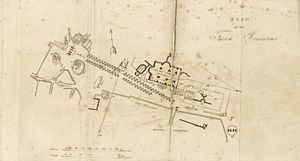Mariana Starke facts for kids
Quick facts for kids
Mariana Starke
|
|
|---|---|
| Born | 30 September 1762 Epsom, Surrey |
| Died | 1 April 1838 (aged 75) Milan |
| Occupation | Travel writer, dramatist, translator, poet |
| Language | English |
| Notable work | Letters from Italy (1800), Travels on the Continent (1820), Travels in Europe (1828 |
| Relatives | Thomas Starke (great-grandfather) |
|
|
|
Mariana Starke (born in 1762, died in 1838) was an important English writer. She is most famous for her travel guides about France and Italy. These guides were very popular with British people traveling in Europe in the early 1800s. Before writing travel guides, she wrote plays and worked as a translator. Later in her life, she also wrote poetry.
Contents
Mariana Starke's Life and Career

Mariana Starke was born in Surrey, England, in 1762. Her mother was Mary Starke, and her father was Richard Starke. Her father worked for the East India Company, a big trading company. He used to be a leader at Fort St George in Madras (now called Chennai) in India. For a long time, people thought Mariana was born in India, but it's now known she was born in England. She was the first of her parents' children to survive past infancy. She grew up at her family's home, Hylands House, in Epsom.
Mariana Starke knew many other writers during her life. A family friend named William Hayley, who was a writer and biographer, helped guide her from a young age. Early in her career, she worked with other writers like Millecent Parkhurst and George Monck Berkeley. She was also friends with writer Catherine Maria Fanshawe.
Starke started her writing career by creating plays. Her first published work in 1787 was a translation of a French play collection called Théâtre de l'éducation. She worked on this with her friend Millecent Parkhurst. Her family had connections to India, and she used this background for her first play performed in a theater, The Sword of Peace (1788). Her second play, The Widow of Malabar (1790), was very successful. It was a big show with special music and an Indian setting.
Between 1791 and 1798, Starke traveled to France and Italy with her parents and sister. Her family members were sick, and she took care of them. Her sister Louisa died in 1792, and her father Richard died in 1794. Living abroad and caring for her family gave her many ideas for her future travel books. After the Napoleonic Wars ended, Starke went back to Italy. She spent the rest of her life updating her travel guides, changing how they were written. It can be tricky to list all her works because she often updated her guides and sometimes changed their names.
How Travel Guides Changed Because of Her
Before Mariana Starke, travel guides mostly described buildings and beautiful places for rich young men on the "Grand Tour" (a long trip through Europe). Starke realized that after 1815, many more British people were traveling. Most of them were families, and they often had a budget.
So, Starke added new kinds of advice to her guides. For the first time, she included tips on:
- What luggage to bring
- How to get passports
- The exact cost of food and hotels in each city
- Advice on how to care for sick family members (which she knew a lot about from her own travels)
She also created a system using exclamation marks [!!!] to rate places. This was like the star ratings we see today for hotels or restaurants. Starke's travel guides were published by John Murray and were so popular that they had many new editions and were often copied by others. The last version of her book Travels in Europe came out in 1839.
Her books became a model for later travel guides, and she became famous during her lifetime. A French writer named Stendhal even mentioned her in his 1839 novel The Charterhouse of Parma. In the book, a British traveler always checked Mariana Starke's book to find out the price of things like a turkey, an apple, or a glass of milk.
Mariana Starke's Writings
Plays
- Theatre of Education (1787): An anonymous translation with Millecent Parkhurst.
- Ethelinda: A play she wrote with George Monck Berkeley, but it was never performed or published.
- The Sword of Peace; or, a voyage of love (1789): A comedy first performed in 1788.
- The British Orphan: An unpublished play performed privately in 1790.
- The Widow of Malabar (1791): A tragedy performed in London in 1790.
- The Tournament (1801): A tragedy based on a German play, performed in 1800.
Poetry
- The Poor Soldier; an American Tale (1789): A poem dedicated to Mrs. Crespigny.
- The Beauties of Carlo Maria Maggi, paraphrased: to which are added Sonnets, by Mariana Starke (1811): Her own sonnets and poems inspired by Carlo Maria Maggi.
Travel Writing
- Letters from Italy, Between the Years 1792 and 1798 (1800): This book shared her experiences and advice from her travels in Italy. It was later reprinted as Travels in Italy.
- Travels on the Continent (1820): This guide was written especially for travelers. It had many editions and was later called Information and Directions for Travellers on the Continent. It was expanded and republished as Travels in Europe in 1832.
- Travels in Europe between the Years 1824 and 1828 (1828): This book was also for travelers and included information about Sicily.
See also
- Guide book
- Travel literature
- Women and the Grand Tour

